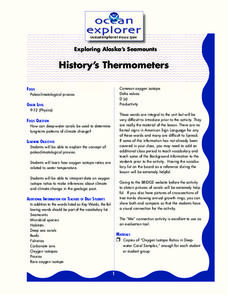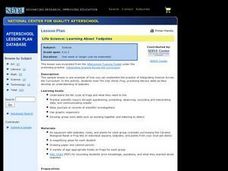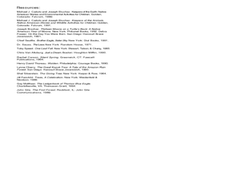Curated OER
Hot Food
Students compare and contrast photosynthesis and chemosynthesis as processes that provide energy to biological communities. They investigate the energy content of hydrocarbons used in coral communities.
Curated OER
History's Thermometers
Students explain the concept of paleoclimatological proxies. In this oxygen isotope lesson, students interpret data and make inferences about climate changes in the geologic past.
Curated OER
Life Science- Learning About Tadpoles
Learners investigate a frog's life cycle. In this tadpole lesson, students observe tadpoles in an aquarium and record results. Learners fill in a KWL chart as an assessment.
Curated OER
Carrying Capacity of Ecosystems
Students define population and carrying. In this algebra lesson, students explore exponential growth and decay based on animals and things that grow or decrease exponentially. They graph their findings and discuss their results as they...
Curated OER
Beach Life: Clam Dissection
Students investigate clams. In this clam life lesson, students conduct an experiment where they dissect clams. Students compare anatomies of humans and clams.
Curated OER
Cathedral in the Sea
Students construct a model giant kelp and kelp forest inhabitants based on field-guide photographs. Students also place animal cutouts in appropriate positions on or near the plant.
Curated OER
Sharks: Scavenging Stomachs
Students examine the role played by sharks in the marine food chain. They conduct a scavenger hunt collecting items that have actually been removed from the stomachs of sharks, and create a display that includes the items and newspaper...
Curated OER
Alphabetical Autobiography PowerPoint
Sixth graders produce an autobiography, They complete a PowerPoint including one graphic image on each slide, and a subtle or moderate animation. They include 26 slides for each letter of the alphabet, use note pages to present...
Curated OER
Our Own City
Students will construct their own functioning city. Each day students will add to the city requiring adjustments and planning. They solve problems caused by increase in human settlement such as stacking houses creating apartments so that...
Curated OER
Bryophytes
In this bryophytes worksheet, students will use an idea map comparing mosses and liverworts to complete 2 short answer questions and 1 true or false question.
Curated OER
Red Tail Ridge Wetland Study Project
Fifth graders use a real life scenario of the wetlands to gather information on creatures of the habitat. In this wetlands lesson, 5th graders research the interdependence of organisms in a healthy habitat. Students collected...
Curated OER
The Living Environment
Young scholars use a spoon, clothespin, scissors, and toothpicks to simulate how animals get food in their environment. For this environment lesson plan, students learn about the adaptations animals make in order to survive.
Curated OER
Elephants
Students study elephants and the features they have that help to keep them cool. In this elephants lesson students research a feature of the elephant.
Curated OER
Clay Ants: Insect Anatomy
Students examine anatomic structures in order to identify insects from other living organisms. They gain a level of comfort from anxiety when observing and handling live and pinned insects. They create clay models of an insect.
Curated OER
The Spider's Life Cycle
Students see that spiders have a life cycle, and reproduce by laying many eggs. We can count by ones, twos, fives, or as many as we want. They make two lists of animals on a chart.
Curated OER
Cranimals in 3D
Students design their own mix and match animals, using lesson framework that emphasizes transformation, explore differences between clay and model magic, experiment with clay, and shape their animals into 3D sculptures.
Curated OER
Biodiversity - Who Cares?
Students articulate some of the impacts of loss of biodiversity. They play a game that demonstrates why having a rich variety of life is important to the survival of ecosystems and how invasive species are threatening local biodiversity.
Curated OER
Small Pond Creatures
Students complete a unit about the different creatures that can live in a small pond habitat. They create a glossary, create a class Small Pond mural, develop a Frog Fact File, read a variety of books, and conduct research for a report...
Curated OER
Activity 2: Salinity & Tides
Students explore the effects of tides and salinity on an estuary. In this salinity and tides lesson plan, students complete 3 activities which help them understand estuarine systems. They study the tides in the Chesapeake Bay, they study...
Curated OER
Reconstructing a Fossil Pterosaur
Students reconstruct the skeleton of the fossil Scaphognathus crassirostis. In this fossil lesson plan, students discuss the Kingdoms of life, geologic history and the history of the skeletons of species. Students are given 20 minutes to...
Curated OER
This Old Tubeworm
Students plot data to construct and interpret a graph about vestimentiferans at cold-seep sites in the Gulf of Mexico. In this deep sea lesson, students plot data provided for the growth of tubeworms. They use the graphs to determine...
Curated OER
My Wet Robot
Students design an underwater vehicle. For this engineering lesson, students will design an underwater robot that includes specific systems for it to function properly. Each group will present their prototype to the class.
Curated OER
What's Down There
High schoolers write an essay about the coral reefs. In this oceanography instructional activity, students investigate the reef of Bonaire and compare it to reefs that are not thriving. High schoolers then explore the differences that...
Other popular searches
- Animals Water Habitats
- Animal Water Habitats
- Land or Water Habitats
- Shallow Water Habitats
- Water Habitats Lesson Plans
- Describe Water Habitats
- Water Habitats Rivers

























